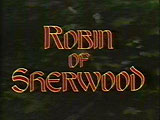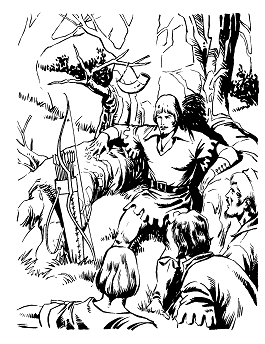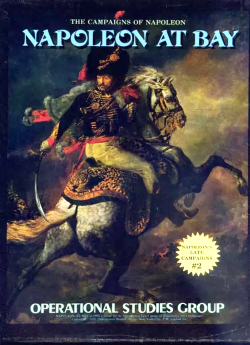
The Legend of Robin Hood is a board game published by Operational Studies Group (OSG) in 1979, and later republished by Avalon Hill that is based on the legendary outlaw Robin Hood and his nemesis, the Sheriff of Nottingham.

The Legend of Robin Hood is a board game published by Operational Studies Group (OSG) in 1979, and later republished by Avalon Hill that is based on the legendary outlaw Robin Hood and his nemesis, the Sheriff of Nottingham.
The Legend of Robin Hood is a 2-player microgame set in Sherwood Forest and in the area around it. One player controls Robin Hood, who must recruit a loyal band of men to help him rob from the rich and give to the poor. The other player controls the Sheriff of Nottingham, who uses soldiers to attempt to guard travellers and capture Robin's men. [1]
The ziplock bag with cover art sheet contains:
The Avalon Hill edition added a game box. A 6 sided die is also needed to play.
At the start of the game, Robin Hood and unrecruited outlaws are scattered across the board, while the soldiers are gathered in three castles. Robin must recruit others to his band, who then rob travelers in the forest to generate income. Robin must engage in personal combat with several would-be leaders, and if wounded, must remain inactive for a turn, which may lead to his capture. [2] Will Scarlet, Alan-a-Dale and Maid Marion appear at random times and locations. If non-leaders are captured and hanged by the Sheriff, replacements can be recruited. However, if named leaders are hanged, they cannot be replaced. When Will and Alan appear, they are unrecruited and face no danger from the soldiers until they join the Merry Men. However Maid Marion is automatically part of the Merry Men, and can be captured by the soldiers the turn she appears unless Merry Men reach her first. If the Sheriff captures and hangs Robin, the game is over. One of Robin's victory conditions is to wed Maid Marion before the villainous Sir Guy can force her to wed, and he can do that by being in the same area as Maid Marion and Alan-a-Dale. [2] King Richard I appears near the end of the game, giving Robin Hood a chance to enter the same area as the king and gain a pardon, another of his victory conditions, and the one that ends the game immediately. [3]
Robin Hood must be free at the end of the game and achieve 3 out of 4 victory conditions:
The Sheriff wins by either preventing Robin from achieving three victory conditions, by hanging Robin (ending the game immediately), or by holding Robin captive at the end of the game.
Several games published by OSG in the 1970s such as Arcola and Devil's Den were bought and republished by Avalon Hill. Such was the case with The Legend of Robin Hood, a game designed by Joe Bislo with artwork by Larry Catalona, and published as a ziplock bag microgame by OSG in 1979. Avalon Hill subsequently bought the game and republished it in 1983 as a small boxed set.
In Issue 78 of Games & Puzzles, Nick Palmer reviewed the OSG edition and called it "An unpretentious but clever interpretation of the traditional Sherwood Forest saga." However, Palmer found the game to be unbalanced in favor of the sheriff, saying, "After a few games, I find it hard to see how Robin can win without a great deal of luck." He concluded by giving the game a below-average Excitement rating of 2 out of 5, saying, "Quite fun, and a neat little problem, but too diffuse with its numerous small skirmishes and a strong chance element to be altogether satisfying as a game. A good one to try on non-gamers, though." [2]
Richard A. Edwards reviewed the original edition in The Space Gamer No. 34. Edwards commented that "For a fun, fast, and thoroughly delightful game, the price is certainly a steal. I recommend The Legend of Robin Hood to all." [1]
In the October 1980 issue of Fantastic , game designer Greg Costikyan wrote "Robin Hood seems to contain most of the elements of the legend — but play drags a bit." [4]
Mike Dean reviewed the Avalon Hill edition for Imagine magazine, and stated that "The Robin Hood stories could be resolved into a good game - I would not say this was it. but if you like two player games, this one is not bad." [5]
At the 1983 Origins Awards, the Avalon Hill edition of The Legend of Robin Hood was a finalist for the Charles S. Roberts Award for "Best Fantasy Board Game of 1982". [6] [7]

Robin Hood is a legendary heroic outlaw originally depicted in English folklore and subsequently featured in literature, theatre, and cinema. He stole from the rich and gave to the poor. According to legend, he was a highly skilled archer and swordsman. In some versions of the legend, he is depicted as being of noble birth, and in modern retellings he is sometimes depicted as having fought in the Crusades before returning to England to find his lands taken by the Sheriff. In the oldest known versions, he is instead a member of the yeoman class. He is traditionally depicted dressed in Lincoln green.

Robin of Sherwood is a British television series, based on the legend of Robin Hood. Created by Richard Carpenter, it was produced by HTV in association with Goldcrest, and ran from 28 April 1984 to 28 June 1986 on the ITV network. In the United States it was shown on the premium cable TV channel Showtime and, later, on PBS. It was also syndicated in the early 1990s under the title Robin Hood. The show starred Michael Praed and Jason Connery as two different incarnations of the title character. Unlike previous adaptations of the Robin Hood legend, Robin of Sherwood combined a gritty, authentic production design with elements of real-life history, 20th-century fiction, and pagan myth. Robin of Sherwood has been described by historian Stephen Knight as "the most innovative and influential version of the myth in recent times". The series is also notable for its musical score by Clannad, which won a BAFTA award. A video game adaptation, Robin of Sherwood: The Touchstones of Rhiannon, was released in 1985. The series attained cult status worldwide.

Sir Guy of Gisbourne is a character from the Robin Hood legends of English folklore. He first appears in "Robin Hood and Guy of Gisborne", where he is an assassin who attempts to kill Robin Hood but is killed by him. In later depictions, he has become a romantic rival to Robin Hood for Maid Marian's love.
Maid Marian is the heroine of the Robin Hood legend in English folklore, often taken to be his lover. She is not mentioned in the early, medieval versions of the legend, but was the subject of at least two plays by 1600. Her history and circumstances are obscure, but she commanded high respect in Robin’s circle for her courage and independence as well as her beauty and loyalty. For this reason, she is celebrated by feminist commentators as one of the early strong female characters in English literature.

Conquests of the Longbow: The Legend of Robin Hood is a graphic adventure game designed by Christy Marx and published by Sierra On-Line in 1991. It is the second and final part of the Conquests series, which begins with Conquests of Camelot: The Search for the Grail. It features VGA graphics and Sierra's standard icon-driven interface first seen in King's Quest V.
Alan-a-Dale is a figure in the Robin Hood legend. According to the stories, he was a wandering minstrel who became a member of Robin's band of outlaws, the "Merry Men".

Robin Hood: Prince of Thieves is a console game released in 1991 for the Nintendo Entertainment System and Game Boy developed by Sculptured Software, Inc. and Bits Studios, respectively, and published by Virgin Games, Inc. Versions for Master System and Game Gear were also announced but cancelled. It was based on the film of the same name.
Robin Hood Rescuing Will Stutly is Child ballad 141, about Robin Hood.

Robin Hood: The Legend of Sherwood is a 2002 stealth-based real-time tactics video game developed by Spellbound Entertainment. It is similar to games such as Desperados: Wanted Dead or Alive and the Commandos series. In the game, the player controls up to five characters in a setting based on the stories of the protagonist, Robin Hood. The player can also control Robin Hood's Merry Men, including Little John, Friar Tuck, Will Scarlet, Will Stutely, and Maid Marian. Robin and his crew must evade the cruel Sheriff of Nottingham and his henchmen and stop the machinations of the vile usurper to England's throne, Prince John. However, Robin must avoid killing enemies as much as possible, or he will not be able to recruit as many new Merry Men.

The folkloric hero Robin Hood has appeared many times, in many different variations, in popular modern works.

Operational Studies Group, also known as OSG, is a publisher of board wargames.

The Merry Men are the group of outlaws who follow Robin Hood in English literature and folklore. The group appears in the earliest ballads about Robin Hood and remains popular in modern adaptations. History The Merry Men are Robin Hood's group who work to rob from the rich and give to the poor. They have antagonized the tyrannical rule of Prince John while King Richard is fighting in the Crusades. This also puts them into conflict with Prince John's minions, Guy of Gisbourne and the Sheriff of Nottingham.
The Sheriff of Nottingham is the main antagonist in the legend of Robin Hood. He is generally depicted as an unjust tyrant who mistreats the local people of Nottinghamshire, subjecting them to unaffordable taxes. Robin Hood fights against him, stealing from the rich, and the Sheriff, in order to give to the poor; it is this characteristic for which Robin Hood is best known. The Sheriff is considered the archenemy of Robin Hood, as he is the most recurring enemy of the well-known outlaw.
Robin Hood is a comic opera by Reginald De Koven (music), Harry B. Smith (lyrics) and Clement Scott. The story is based on the Robin Hood legend, during the reign of King Richard I. The opera was composed in Chicago, Illinois during the winter of 1888-1889.

Robin Hood is a fictional character appearing in media published by DC Comics, based on the legendary character of the same name. The character debuted in New Adventure Comics vol. 1 #23, and was created by Sven Elven.

A Challenge for Robin Hood is a 1967 British adventure film directed by C. M. Pennington-Richards and starring Barrie Ingham, Peter Blythe and John Arnatt.

Hood: Outlaws & Legends is an action video game developed by Sumo Newcastle and published by Focus Home Interactive. The game was released for Microsoft Windows, PlayStation 4, PlayStation 5, Xbox One and Xbox Series X and Series S on May 10, 2021.

Arcola, The Battle for Italy 1796 is a board wargame published by Operational Studies Group (OSG) in 1979 and republished by Avalon Hill in 1983 that is a simulation of the Battle of Arcola between French and Austrian forces in 1796. The game was designed to tempt players to purchase OSG's previously published and larger wargame Napoleon in Italy.

Napoleon at Bay, subtitled "Prelude to Waterloo: The Campaign in France, 1814", is a board wargame published by Tactical Studies Group/Operational Studies Group in 1978 that is a simulation of Napoleon's attempts to keep the Allies out of Paris in the early months of 1814.
{{cite magazine}}: CS1 maint: date format (link)